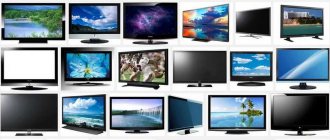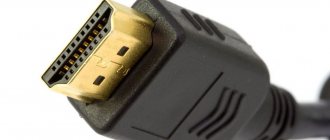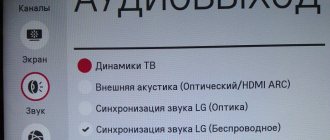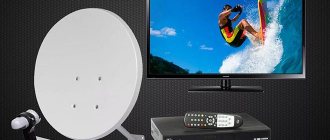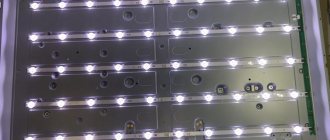It is quite difficult for even many experienced users to understand what types of TV matrices exist, primarily due to the marketing component of the issue. Many brands began to come up with new names to increase demand for new collections of their products. We will try to figure out which TV matrices are better in 2021, taking into account the features and types of technologies.
First of all, you should understand that all LED TVs come in three types:
- TN matrices are the most budget-friendly and no longer relevant type;
- VA matrices – have a fast response, are good for games, but do not have a wide enough viewing angle;
- IPS matrices attract with good color rendering, visibility, balanced price and characteristics.
The best matrices for TVs for 2021
VA and IPS - which matrix is better?
Actually, this confrontation has been going on for many years. Before the advent of premium matrices with organic LEDs, there were only LCD TVs, which are still popular today even in the segment of good 4K TVs.
Relatively speaking, Vertical Alignment (VA) and In-Plane Switching (IPS) work on the same principle: they pass the backlight through tiny liquid crystal structures. In terms of color rendering and brightness, much depends on the specific model, but there are differences in a number of parameters.
Black level
One of the few parameters in which VA matrices clearly lead over their competitors, and produce black color at the level of 0.020-0.015 Nits. For IPS matrices, the brightness level of the black tint is several times worse - around 0.07-0.09 Nits. What does this indicator affect?
- High dynamic range (HDR) display quality;
- Perception of other colors in contrast (general background);
- Overall contrast level.
Color rendering level
In terms of the level of color rendering, it is difficult to identify a clear leader. Still, a lot also depends on the class, and not the type of matrix. So, for example, 10-bit IPS will be better than 8-bit VA, as well as vice versa. The characteristics are also revealed by HDR. In general, today there are many mid-range models with support for more than 1 billion shades.
At the same time, we must not forget about the depth of black color in VA matrices, which is why, with the same color gamut, the picture on such TVs may visually look more saturated.
Playing action scenes
Of course, a lot depends on the frame rate, but by default IPS matrices are better at reproducing dynamic content than VA. Combined with a wide viewing angle, watching sports TV shows or action films is more enjoyable.
Conclusion: which is better IPS or VA?
Comparing IPS and VA TVs, we can draw the following conclusions:
- VA matrix is better suited for gaming monitors and TVs;
- The IPS matrix is better suited for viewing dynamic scenes.
Don’t also forget that each specific line has various image enhancement technologies. Often they play a major role. Our conclusion is subjective.
Types of matrices
Modern televisions have systems whose operation is based on liquid crystals. They were discovered back in the 19th century, but they have only come into use now. At the moment they have their own division into types.
TN matrices
The system is used in many low-priced TVs. Additional coating is used in the work. It allows you to expand viewing angles.
Advantages of TN matrix:
- thanks to the technology used, it is possible to obtain the color range necessary for the eye and perception;
- the matrix has a relatively low price;
- fast response of cells to operation, colors are transmitted instantly.
Equipment with this type of matrix is valued for its efficiency in terms of energy consumption.
TN is not the best solution for a modern TV. This is all due to the difficulty of coordinating the simultaneous rotation of the crystal flasks.
It turns out that some pixel blocks have already completed a full rotation, while others are still in the process and transmit light. At different viewing angles, the color of the picture varies. For example, if you look straight on, the ball is black, but when viewed from the side, it has a pronounced gray tint.
Another disadvantage of the TN matrix is the inability to reflect the entire color gamut that is originally in the material. The developers tried to compensate for this by introducing an algorithm into the screen that can replace missing colors.
For demanding viewers, a TV with such a built-in system is not suitable.
IPS matrices
This is the most expensive type of matrix. It was developed at the Hitachi equipment manufacturing plant. Later, the matrix began to be used in LG and Philips TVs
The matrix allows you to view video on the screen at angles of 180 degrees.
The main difference between the IPS matrix and others is the technology of darkened dead pixels. The process occurs when there is a malfunction between the electrode and the crystal. In this case, the location of the violation begins to be highlighted in gray. This helps smooth out the visual sensations.
The most important advantage highlighted by users and developers themselves is response time. From 25 to 16 ms.
The disadvantages of the IPS matrix are:
- a pronounced grid between pixels;
- the likelihood of a sharp drop in the contrast level;
- high cost of goods with such a system.
You can often find equipment with an IPS matrix in photo studios and in halls where presentations are held.
VA matrices
According to a survey of users, VA matrices became one of the best. Its advantages are:
- Crystals in such a design can mix with each other.
The result is a clear and rich image. Due to the cylinders of crystals, which are located perpendicularly, the black color has a natural character. - The color saturation is maintained.
Because the VA matrix can change its position, this helps transmit sunlight. Glowing snow-white and colored dots nearby help maintain contrast. - Coarse mesh composition inside the filters.
Regardless of the viewer's position, the crystals will be oriented towards the person's gaze.
The only drawback of VA is its slow response. The developers began implementing the current system. With its help, the problem will soon be resolved.
TVs that contain VA are best installed in:
- halls designed for long conferences;
- houses with a large living room;
- offices as a way to broadcast presentations;
- bars to watch football matches.
OLED and QLED matrices
The main principle of development is to increase the level of contrast, increase the depth of black tint and ensure high color gamut on the TV screen. In plasma panels with OLED matrices, each LED lights up. If no light reaches it, it remains perfectly black.
Organic LEDs are the basis of the technology. OLED matrices do not require additional backlighting. This is because each panel cell is an individual light source.
Main advantages:
- high contrast level;
- uniform illumination;
- wide viewing angles;
- high maintainability (in case of breakdowns, the failed section can be replaced).
However, the OLED matrix still has disadvantages:
- short service life (2-3 years, if you use the equipment moderately);
- high production costs;
- any liquid can harm the system.
QLED technology, in theory, has a lot in common with OLED. The operating principle is the same, but QLED uses quantum dots. The QLED matrix can be seen in Samsung TVs.
I loved the QLED matrix for:
- presence of bright colors;
- no burnout;
- a high resolution;
- visualize sharp colors even at maximum brightness.
The QLED matrix has only one disadvantage - high cost.
How are NanoCell matrices different from LG?
If you don’t know which matrix to choose for a mid-range TV, then you should pay attention to NanoCell from LG. There are no alternatives in the LED screen segment yet, and the fact that the best LG TVs occupy more than 60% of the European market is proof of this. How does this type of technology differ from IPS and VA?
In fact, NanoCell is an upgraded IPS technology that filters colors much more efficiently, which guarantees a high-quality picture.
In terms of viewing angle and reproduction of dynamic scenes, this technology is in no way inferior to simple LED alternatives.
LCD
This technology is very popular among TV manufacturers. LCD matrices use a viscous liquid (crystal). Electrical voltage causes a synchronous change in the orientation of molecules in space. Due to this, transparency is managed.
Such matrices consist of several components:
- Liquid crystals.
- Transparent electrodes. They are located on both sides and control the ability of the crystals to transmit light.
- Color filter.
- Screen backlight. Located behind the matrix.
- Film or glass. They cover the front part of the matrix.
Why is QLED matrix better than NanoCell?
It’s worth saying right away that QLED technology involves the use of “quantum dots,” which is radically different from liquid crystal LED TVs. This technology was presented by Samsung, positioning its matrices as something excellent and inimitable, but after some time it became clear that the final stages of development are still very, very far away.
QLED matrices are indeed very bright, in which Nano Cell is inferior to them. But it’s difficult to call the matrix ideal, since it’s essentially VA with an additional film between the liquid crystals. In the future, quantum rods may indeed appear, which will allow Samsung's best TVs to compete with competitors' OLED panels, but for now they themselves order other panels for many of their lines. First, QLEDs use a lot of energy. Secondly, due to the additional layer they are larger.
Diagonal size
The formula for determining a “comfortable” display diagonal was once considered effective. It is necessary to multiply the diagonal in centimeters by a factor of 2.5-3, after which we get a comfortable distance from the viewer to the screen. For example, a 50-inch TV “should” be positioned about 3.8 meters away from the viewer. However, this formula was relevant for Full HD. If we return to modern reality, this is more an indicator of maximum rather than minimum removal.
Why? Ask gamers: they sit well if they are a couple of meters from the screen - otherwise it’s uncomfortable. It is also more pleasant to immerse yourself in a movie when you are close to the picture, when it occupies almost the entire field of view. The main thing is not to get a headache.
If the video source is “so-so” (for example, the low resolution of the broadcast IPTV), at a large diagonal and at close range you will see huge “pixels”, muddy faces and blurry inscriptions. Artificial intelligence cleaning up letters won't help either.
Briefly: the higher the resolution of the matrix with a suitable resolution of the source video signal, the closer to the large diagonal TV you can sit.
The choice of diagonal is partly a subjective aspect. As practice shows, if 50 inches seems like a large screen size, in six months you will want 55 or 60 - a matter of habit. There are two points: the price and the size of the room where the TV will be placed. There is usually a lot of space in a store, and the diagonal is lost; the TV looks smaller than in the room. Now, if you have the means, diagonals from 50 to 65 inches can be called “fashionable” for an “ordinary” apartment.
According to Vasily, in his practice, TVs with smaller diagonals are more common.
“32-43 inches are the most popular, 80 percent of them. Those larger are much less common,” he says and suggests that this reflects the prevalence of popular models among consumers.
The best matrix of 2021 for TVs is OLED!
In our subjective opinion, the best matrix for TVs is OLED. Such TVs operate on the basis of pixels, each of which represents a separate light source. The technology has already been perfected and provides for energy savings (unnecessary pixels do not require electricity), as well as space in the panel. In addition, the advantages of OLED TVs include:
- Best response time;
- Maximum viewing angle;
- High contrast;
- The deepest black color.
The QLED matrix is only better in terms of color accuracy, but a lot depends on image enhancement technologies, and LG’s processors are very powerful. However, like another South Korean manufacturer.
What to choose - glossy or matte display?
It remains to consider the question of which screen is better - matte or glossy for a TV, and why. Here the choice depends on the place in the apartment where the equipment will be hung, and personal feelings. On gloss, the picture looks bright and clear. Matte displays create a hazy effect that can be unpleasant on the eyes. But in bright rooms where there is a lot of sunlight (especially towards equipment), it is more comfortable to watch TV with a matte monitor. There is less glare on its surface, which means less distortion.
It is quite difficult to give a definite answer to the question which TV screen is better . After all, when choosing, the size of the monitor, the budget, personal perceptions, the purpose of the equipment, and even the room in which it will be used are of great importance. But if the quality of the reproduced picture and the feeling of viewing dynamic scenes is important, you should take a closer look at LCD LED or OLED options.
TV displays
When buying and choosing a TV, the main criterion is the display (matrix) of the device. The matrix or display is the part of the device that is installed in the middle between the film and glass walls. And it is a set of electrodes (transparent) that are arranged in such a way that they do not touch each other, while they are installed on two planes, it is this mechanism that gives the quality of color rendering and displays the image on the screen. Different types of matrices are installed on different TV models, the most common types are LCD, plasma, LED, also QLED and ULED, IPS, VA.


